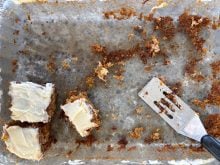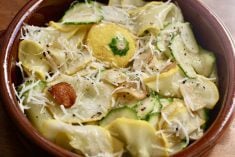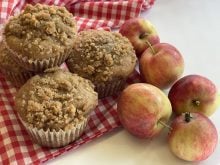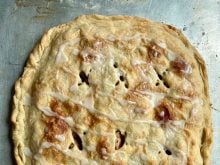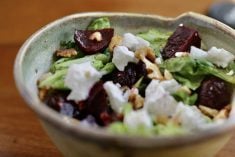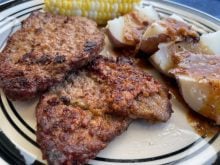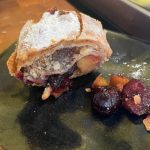Considering that a preserved loaf of bread was found in Pompeii, we assume that all types of breads were created a long time ago.
However, it isn’t always the case. The French baguette was created in the early 1900s and Italian ciabatta in 1980s. The first ciabatta was made in 1982 in Verona, Italy, and we know this because the maker filed for a trademark.
In the 19th century, bread was a major source of calories for people in the United Kingdom and France, which explains the large, hearty loaves of the time.
Read Also

Producer profits remain under significant pressure
Manitoba farmers are facing down a double hit of high input costs, like fertilizer, and low grain prices as they harvest their next crop.
Winter is a great time to try new bread recipes. We usually have more time for this during the winter, and we also crave carbohydrates more in the winter.
Multigrain bread
- 1 1/4 c. seven-grain hot cereal mix 310 mL
- 2 1/2 c. boiling water 625 mL
- 3 c. all purpose flour 750 mL
- 1 1/2 c. whole wheat flour 375 mL
- 1/4 c. honey 60 mL
- 1/4 c. butter, melted and cooled 60 mL
- 2 1/2 tsp. instant or rapid-rise yeast 12 mL
- 1 tbsp. salt 15 mL
- 3/4 c. unsalted pumpkin or sunflower seeds, optional 175 mL
- 1/2 c. old-fashioned rolled oats 125 mL
Place cereal mix in bowl of stand mixer fitted with dough hook and pour boiling water over it. Let stand, stirring occasionally, until mixture cools to 100 F (40 C) and resembles thick porridge, about one hour. Whisk flours together in separate bowl. Add seeds to flour, if using.
Once grain mixture has cooled, add honey, butter and yeast and mix on low speed until combined.
Add half of the flour to the mixture and then half a cup at a time, mixing on low after each addition. Continue adding flour until the dough pulls away from the sides of the mixing bowl.
Don’t add too much or you will make a hard dough. You want it to be soft but not sticky.
Knead in the stand mixer until dough is elastic, about five minutes. When fully kneaded, place dough in a lightly greased bowl and turn over in the bowl so the surface of the dough is also greased. Cover with kitchen wrap and a clean tea towel. Place in a warm spot and let rise until nearly doubled in size, about an hour.
Grease two nine by five inch (22×12 cm) loaf pans. Transfer dough to lightly floured countertop and knead a couple of times. Form into two long loaves with the seam on the bottom. Place in loaf pans and cover loosely with kitchen wrap and let rise at room temperature until doubled in size, 30 to 40 minutes. Sprinkle loaves with oatmeal.
Thirty minutes before baking, preheat oven to 375 F ( 190 C). Bake loaves until the internal temperature is 190 F (87 C). Transfer pans to wire rack and cool for five minutes. Remove bread from pans and let bread cool on rack to room temperature, about one hour, before slicing.
Bannock
This recipe was shared by Cree elder Jean Cunningham. It is a basic recipe that can be cut into serving size pieces, left whole, cooked wrapped on a willow branch over a wood fire oven, baked or fried. If frying, omit the lard.
- 6 c. flour 1.5 L
- 3 tbsp. baking powder 45 mL
- 1/2 tsp. salt 2 mL
- 1/2 c. lard 125 mL
- 3 c. water 750 mL
Preheat oven to 450 F (230 C). Grease a baking sheet with lard.
Whisk to combine dry ingredients in a large bowl. Work in lard with fingertips until evenly distributed and in small pea-sized pieces.
Make a well in the centre of the dry ingredients. Add water and stir the flour in from the sides until it is mostly incorporated. As the dough becomes too thick to stir, flour your hands and work the dough. Turn the dough onto a lightly floured countertop. Knead until smooth.
Pat into a large rectangle until about one inch (2.5 cm) thick. Prick all over with the tines of a fork.
Cut into individual pieces with a knife or round cookie cutter or leave it whole. Place on greased cookie sheet and bake at 450 F (230 C) for about 35 minutes or until golden brown. Remove from the oven and when cool enough to handle, about a minute or two, turn over on the pan so the excess moisture can escape.
Serve with butter and jam.
Gluten-free sourdough
This recipe is measured by metric weight, and I find this to be most reliable. The flour is very fine and compacts easily, making volume measurements unreliable. I used Caputo gluten-free brand flour and adapted the recipe from the company’s website. This is essentially a no-knead bread recipe.
- 450 g gluten-free flour, plus extra for kneading and shaping
- 20 g extra virgin olive oil
- 385 g water, room temperature
- 10 g sugar
- 5 g salt
- 100 g active gluten-free starter
Starter
In a large mason jar, combine 50 grams of gluten-free flour and 65 grams of water.
Mix until there are no lumps. Place the jar on your counter and cover it loosely.
On the second day add 30 grams gluten-free flour and 40 grams water and mix until there are no lumps. Continue this process every 24 hours for another 10 days. This will allow the starter to mature. Discard half the mixture after Day Four and Day Eight. The discard can be saved to use at a later time.
On Day 12, the starter should be active, bubbly and ready to use.
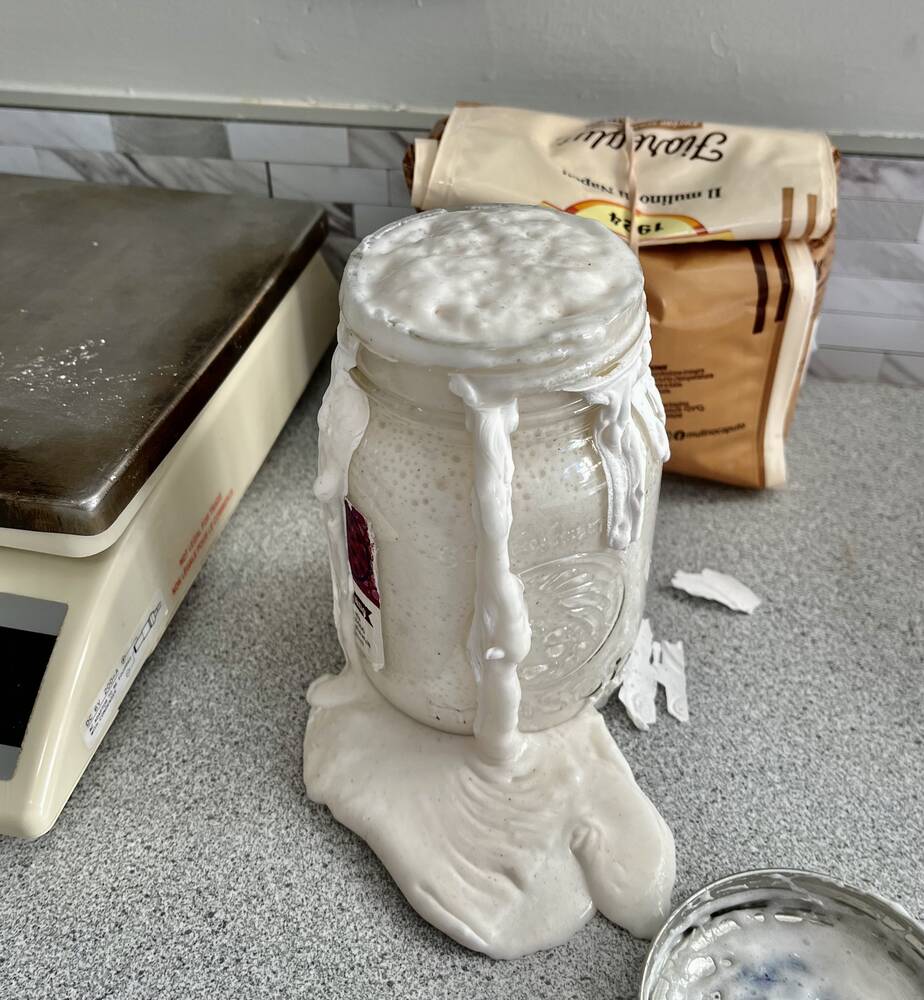
Dough
In a large bowl, combine water, olive oil, sugar, salt and active gluten-free sourdough starter. Once combined, add in 450 grams of gluten-free flour. The dough will be sticky. Mix with a rubber spatula and then use your hands, if needed.
Mix for about three to five minutes. It will still be sticky. Cover with a tea towel and place in a warm spot, allowing the dough to double in size, about three to four hours.
Once doubled, cover and place the dough in the refrigerator overnight.
The next day, remove dough from refrigerator and allow it to come to room temperature on the counter, about two hours.
Liberally flour countertop with gluten-free flour. Then turn dough out onto the floured surface and knead for about two to three minutes until it comes together and absorbs the flour on the surface. If it is too sticky to knead, that’s OK — don’t bother.
Shape dough and place on a parchment-lined baking sheet. Loosely cover with kitchen wrap and a kitchen towel. Set it in a warm spot until doubled in size, about six to eight hours.
Preheat the oven to 500 F (260 C). Place a cast iron pan in the oven so it also preheats.
When dough is ready, place it and parchment into the preheated cast iron pan.
Now lower oven temperature to 450 F (230 C) and bake for 40 to 45 minutes, or until golden.
Allow to cool completely before slicing.
Adapted from Caputa Flour.
Portuguese cornbread
- 1 c. milk 250 mL
- 2 tsp. salt 10 mL
- 1/3 c. sugar 75 mL
- 1/2 c. butter 125 mL
- 1/2 c. warm water 125 mL
- 2 tbsp. active dry yeast 30 mL
- 2 eggs, well beaten
- 3 1/2 – 4 c. all purpose or bread flour 875 mL – 1 L
- 1 3/4 c. cornmeal 425 mL
In a small heavy saucepan, warm milk until it steams. Stir in sugar, reserving one teaspoon (5 mL). Stir to dissolve. Add butter and allow to melt. Remove from heat and let cool to lukewarm.
Combine warm water and reserved sugar in the bowl of your stand mixer or a large bowl. Sprinkle the yeast and stir. Let stand for three or four minutes.
Add lukewarm milk mixture, beaten eggs, half of the flour and cornmeal. Beat by hand until all flour has been incorporated into the liquid.
Slowly work in remaining flour and cornmeal using the dough hook of your stand mixer. Continue to add flour until dough is no longer sticky and pulls away from the sides of the bowl. Continue to knead for four or five minutes until dough is elastic and smooth.
Cover and let rise until doubled.
When doubled, punch down, divide in half and shape into two round loaves. Place on a parchment-lined baking sheet dusted with cornmeal. Cover and let rise again until doubled, 45 to 50 minutes.
Bake in a preheated 375 F (190 C) oven until golden brown, about 45 minutes. Cool completely before cutting.
Sarah Galvin is a home economist, teacher and avid supporter of local food producers. She has been a market vendor, grew up on a farm in southeastern Saskatchewan and is a member of TEAM Resources.






